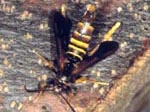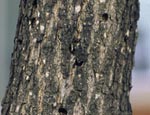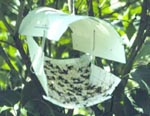
|

Ash/Lilac
Borers
Ash Borer
Podosesia syringae
Lilac Borer Podosesia aureocincta
|
Description
The adults of ash and lilac borers are wasplike moths. The
forewings are a brown to chocolate color. The hindwings are
clear with a brown border and veins. The body is mainly brown.
The legs and abdomen are marked with yellow. The larva is
a creamy white, has a light-brown head, and is about an inch
long when fully grown.
|
Click
on image for larger version

Figure 1. Adult Lilac Borer
|
|
Click
on image for larger version

Figure 2. Lilac Borer Emergence Holes in Ash
|
Life
History
The adult female deposits her eggs in cracks and loose areas
on the bark of the host plant. Emerging larvae maintain contact
with the outside and continue to expel sawdust and frass,
which accumulates around the exit holes. The larvae are half-grown
when they overwinter. They become active again in the spring,
pupating near the end of the burrows. The adults, which are
active flyers, emerge in the middle to later part of June
in Illinois, There is only one generation a year.
|
|
Damage
Infestations by ash or lilac borers result in numerous holes
through the bark and wood. The areas around the holes may
be swollen, with the bark cracked and broken away and the
sap exuding from the holes along with sawdust and frass. Branches
may be severely weakened at the feeding site. During dry periods
in the late summer, terminal shoots may wilt. Severely affected
trees may die.
|
Click on image for larger
version

Figure 3. Ash/Lilac Borer Pheromone Trap
|
|
Click
on image for larger version

Figure 4. Lilac Borer Larva and Damaged Branch
|
Nonchemical
Control
Protecting newly planted trees from the borers will help reduce
problems. Water, mulch, and fertilize the trees as needed
for your area. This helps the trees to become established.
Water and fertilize older trees to reduce stress. Avoid wounds
to the trunk and main branches.
Chemical
Control
Insecticidal sprays can be applied to the trunk and upper
branches in early June and then 4 weeks later.
|
|
|

|

|



